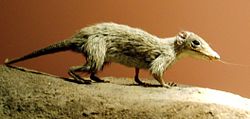Megazostrodontidae
| Morganucodonta Temporal range: Late Triassic – Lower Cretaceous 210–140 Ma |
|
|---|---|
 |
|
| Life restoration of a Megazostrodon, Natural History Museum, London | |
| Scientific classification | |
| Kingdom: | Animalia |
| Phylum: | Chordata |
| Order: | Therapsida |
| Suborder: | Cynodontia |
| Clade: | Mammaliaformes |
| Clade: |
†Morganucodonta Kermack, Mussett & Rigney, 1973 |
| Subgroups | |
|
|
Morganucodonta ("Glamorgan teeth") is an extinct order of basal mammaliaformes, the precursors to crown-group mammals (Mammalia). Their remains have been found in southern Africa, Western Europe, North America, India and China. The morganucodontans were probably insectivorous and nocturnal. Nocturnality is believed to have evolved in the earliest mammals in the Triassic (called the nocturnal bottleneck) as a specialisation that allowed them to exploit a safer, night-time niche, while most larger predators were likely to have been active during the day (though some dinosaurs for example were nocturnal as well).
Morganucodontans had a double jaw articulation made up of the dentary-squamosal joint as well as a quadrate-articular one. They also retained their postdentary bones: the articular and quadrate. There is a trough at the back of the jaw on the inside (lingual) where the postdentary bones sat. The double jaw articulation and retention of the postdentary bones are characteristic of many of the earliest mammals, but are absent today in mammals: all crown-group mammals by definition have a jaw that is composed of a single bone, and the articular and quadrate bones have been incorporated into the middle ear, having become the malleus and incus respectively.
Unlike Sinoconodon and other therapsids, morganucodontan teeth were diphyodont (meaning that they replaced their teeth once, having a 'milk' set and 'adult' set as seen in today's mammals including humans and not polyphyodont (meaning that the teeth are constantly replaced, and the animal and its teeth get larger throughout its lifetime, as in reptiles). Evidence of lactation is present in Wareolestes, via tooth replacement patterns.
...
Wikipedia
